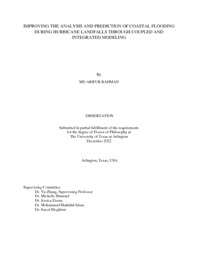| dc.description.abstract | **Please note that the full text is embargoed until 12/16/2024** ABSTRACT: As the intensity and frequency of landfalling tropical storms are likely on the rise in a warming climate, coastal communities are increasingly being exposed to flooding caused by storm surges compounded by heavy rainfall. Prediction and reanalysis of storm surges, especially compound flooding, rely on wind and pressure fields either from parametric tropical cyclone wind models or numerical weather model reanalysis. Both are subject to significant errors during landfall. Besides, land surface attributes and different storm structures influence the intensity and location of compound flooding in coastal areas. Therefore, this dissertation aims to improve the analysis and prediction of coastal flooding during landfalls through integrated modeling by addressing the above research questions. The dissertation is comprised of three main components. First, the relative accuracy of HWRF reanalysis and a parametric wind model (i.e., Holland 10) during the landfall of Hurricane Florence has been assessed, and the impacts of the wind forcing on storm surge simulations have been estimated. In this component of the study, we validated each wind forcing using an extensive surface data set collected at public and commercial platforms and then used as input forcing to a 2-D coastal hydrodynamic model (i.e., Delft3D Flexible Mesh) to produce storm surge along the Carolina coasts and major sounds. This study reveals that the wind fields from HWRF are overall more accurate than those based on H10 for the periphery of the storm, though they exhibit limitations in resolving high wind speeds near the center. However, HWRF wind fields exhibit a progressively negative bias after landfall, likely due to deficiencies of the model in representing boundary layer processes and to the lack of assimilation of the surface product after landfall to compensate for these deficiencies. When we used HWRF reanalysis wind and pressure fields as the atmospheric forcings to the Delft3D-FM model, it yielded more accurate peak surges simulations. However, there is a severe underestimation of the surge along the shoreline close to the track center. The peak surge simulations by Delft3D are biased low when driven by H10, even though over several locations, the H10 model overpredicts surface wind speeds. This contrast highlights the importance of resolving wind fields further away from the center to reproduce storm surges and associated coastal flooding accurately.
The second component of the dissertation focuses on defining an alternative metric to identify regions with consistently large compound zones and land surface controls on the intensity and locations of compound flooding caused by Hurricane Florence. A prominent feature of this event is the storm surge penetrated more than 60 km inland through the Neuse River in North Carolina, causing more than 3-m surge upstream outside of the coastal zone. This surge most likely has magnified the fluvial flood peak that arrived subsequently by producing the backwater effects. Therefore, this investigation focuses on the impacts of land surface controls on the intensity of compound effects. We developed an integrated ocean-riverine hydrodynamic model using the Delft3D-FM suite. The integrated model ingests inflow from National Water Model 2.1 reanalysis. The model undergoes calibration to accurately capture the peak surge up to the surge-dominated and fluvial zones. The calibrated model is then used in sensitivity runs to appraise the impacts of land surface control. The findings from this study confirm that the baseline metric using the compound ratio of 20% and 80% is insufficient to explicitly define Florence's compound zone. However, changing the threshold values of the compound ratio in alternative metrics to 5% and 95 % demonstrates significant compounding effects. So, the alternative metric is more conservative than the baseline. In addition, the presence of salt marsh significantly impacts the compound zone, and the compound area reduces by 35 % for the highest intensity of salt marsh. Therefore, Managing flood hazards using a more conservative estimation will minimize the risk of property damage and save lives.
In the third element, we investigate three contrasting storm events over the Amite River watershed in Louisiana to identify the effects of different storm structures on the intensity and location of compound flooding over the region. To this end, we extensively calibrate an integrated modeling framework (i.e., Delft3D-FM) in simulating compound flooding effects resulting from rainfall runoff, astronomical tides, storm surges, and atmospheric forcing within the Lakes Maurepas and Pontchartrain drainage basins. The calibration was performed on two contrasting events: a rainfall-dominated flood event in 2016 and a surge-dominated (i.e., Hurricane Isaac) event in 2012. Then the resulting model was utilized for Hurricane Ida in 2021 to ascertain the extent of the compound and transition zone. Our intermediate results suggest that surge-dominated events only generate floods within the transition zones, whereas rainfall-dominated events contribute to watershed flooding. However, the study reveals that a surge event with heavy rainfall is the actual cause of compound flooding. Moreover, the location and intensity of compound flooding vary in u/s and d/s. This innovative study suggests that a coupled model can be used for operational use in predicting compound flooding in coastal areas as the model reduces computational time by avoiding the complexity of implementing different modeling frameworks separately with multiple parameter estimations. Hence, the outcome of this study will help policymakers take prompt and informed actions during storm events. | |


